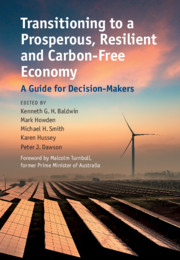Book contents
- Transitioning to a Prosperous, Resilient and Carbon-Free Economy
- Transitioning to a Prosperous, Resilient and Carbon-Free Economy
- Copyright page
- Dedication
- Contents
- Figures
- Tables
- Contributors
- Foreword
- Introduction
- 1 Policy Frameworks and Institutions for Decarbonisation: The Energy Sector as ‘Litmus Test’
- Technologies for Decarbonising the Electricity Sector
- Example Economies
- Cities and Industry
- Land Use, Forests and Agriculture
- 17 Land Use
- 18 Forests
- 19 Agriculture
- Mining, Metals, Oil and Gas
- Addressing Barriers io Change
- Index
- References
19 - Agriculture
from Land Use, Forests and Agriculture
Published online by Cambridge University Press: 08 October 2021
- Transitioning to a Prosperous, Resilient and Carbon-Free Economy
- Transitioning to a Prosperous, Resilient and Carbon-Free Economy
- Copyright page
- Dedication
- Contents
- Figures
- Tables
- Contributors
- Foreword
- Introduction
- 1 Policy Frameworks and Institutions for Decarbonisation: The Energy Sector as ‘Litmus Test’
- Technologies for Decarbonising the Electricity Sector
- Example Economies
- Cities and Industry
- Land Use, Forests and Agriculture
- 17 Land Use
- 18 Forests
- 19 Agriculture
- Mining, Metals, Oil and Gas
- Addressing Barriers io Change
- Index
- References
Summary
Food and agriculture are critical to sustainable and prosperous societies and they need to be a core part of addressing climate change. This reflects both the large contribution that food and agriculture make to global greenhouse gas (GHG) emissions and the large-scale vulnerability of these sectors to climate changes, especially in developing countries. High levels of previous exposure to climate variability have provided some adaptive capacity but this is far from complete, with a growing climate adaptation gap often arising. The projected broadly negative climate changes will interact strongly with other expectations, such as: doubling of food production, provision of emissions reduction options and maintenance of biodiversity and ecosystem services, among others. This chapter identifies the key GHG emissions from agriculture and food systems and how they can be reduced in tandem with ongoing adaptation to climate change: the fundamentals of successful low-emissions, adaptive and prosperous agriculture systems. To date, food and agriculture has received far less policy support and research and development focus than other, often smaller and less vulnerable, sectors. Addressing the interactions between climate change and food and agricultural systems is a challenge we can’t afford to fail and an opportunity we can’t afford not to grasp.
- Type
- Chapter
- Information
- Transitioning to a Prosperous, Resilient and Carbon-Free EconomyA Guide for Decision-Makers, pp. 501 - 526Publisher: Cambridge University PressPrint publication year: 2021



